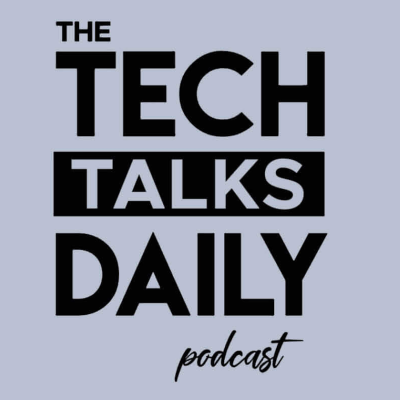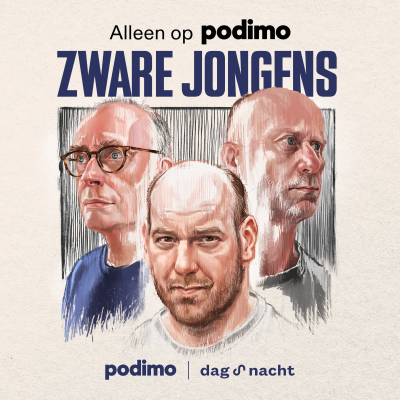
Tech Talks Daily
Engels
Nieuws & Politiek
Tijdelijke aanbieding
1 maand voor € 1
Daarna € 9,99 / maandElk moment opzegbaar.
- 20 uur luisterboeken / maand
- Podcasts die je alleen op Podimo hoort
- Gratis podcasts
Over Tech Talks Daily
If every company is now a tech company and digital transformation is a journey rather than a destination, how do you keep up with the relentless pace of technological change? Every day, Tech Talks Daily brings you insights from the brightest minds in tech, business, and innovation, breaking down complex ideas into clear, actionable takeaways. Hosted by Neil C. Hughes, Tech Talks Daily explores how emerging technologies such as AI, cybersecurity, cloud computing, fintech, quantum computing, Web3, and more are shaping industries and solving real-world challenges in modern businesses. Through candid conversations with industry leaders, CEOs, Fortune 500 executives, startup founders, and even the occasional celebrity, Tech Talks Daily uncovers the trends driving digital transformation and the strategies behind successful tech adoption. But this isn't just about buzzwords. We go beyond the hype to demystify the biggest tech trends and determine their real-world impact. From cybersecurity and blockchain to AI sovereignty, robotics, and post-quantum cryptography, we explore the measurable difference these innovations can make. Whether improving security, enhancing customer experiences, or driving business growth, we also investigate the ROI of cutting-edge tech projects, asking the tough questions about what works, what doesn't, and how businesses can maximize their investments. Whether you're a business leader, IT professional, or simply curious about technology's role in our lives, you'll find engaging discussions that challenge perspectives, share diverse viewpoints, and spark new ideas. New episodes are released daily, 365 days a year, breaking down complex ideas into clear, actionable takeaways around technology and the future of business.
Alle afleveringen
186 afleveringen3517: How AWS and the PGA Tour Are Changing Live Sports Technology
How do you capture every moment of a golf tournament spread across hundreds of acres, tens of thousands of shots, and dozens of players competing at the same time? That question sits at the heart of this conversation recorded at AWS re:Invent, where I sat down with Eric Hansen, VP of Product at the PGA Tour, and Elaine Chiasson, who leads the global golf team at AWS, to unpack how data and AI are reshaping the way fans experience the game. Eric explains why modern professional golf has more in common with Formula 1 than most people realize. Every ball struck, every position on the leaderboard, and every shift in momentum generates data that needs to be processed instantly. With more than thirty thousand shots across a single tournament and only a fraction of them shown on traditional broadcasts, the PGA Tour faces a constant challenge. How do you give fans context, insight, and a sense of presence when most of the action is never seen on screen? Elaine shares how AWS has helped the Tour build the foundation to answer that question. From migrating decades of video and shot data into the cloud to applying generative AI for automated commentary, language translation, and real time insights, this partnership goes far beyond infrastructure. Together, they are experimenting with automated camera switching, AI driven production workflows, and personalized fan experiences that surface the right information at the right moment, whether you are following the leaderboard or a single favorite player. The conversation also digs into trust and accuracy. Eric walks through how the PGA Tour validates AI generated commentary to ensure it stays aligned with the sport's standards, while Elaine highlights why operational discipline and governance matter just as much as innovation. They explore what hyper personalization looks like inside the PGA Tour app, how global broadcasts could evolve, and why the long term opportunity lies in making every shot matter for every fan. As live sports move toward a future shaped by data, automation, and AI agents working behind the scenes, this episode offers a clear look at what that transformation really involves. So as golf continues to blend tradition with technology, what kind of fan experience do you want to see next, and how comfortable are you with AI calling the shots? Useful Links * Connect with Eric Hansen, VP of Product at the PGA Tour. [https://www.linkedin.com/in/ehanson2/] * Connect with Elaine Chiasson [https://www.linkedin.com/in/elaine-chiasson-91256212/] * Learn more about AWS and PGA Tour [https://aws.amazon.com/ai/generative-ai/customers/pga-tour/] Tech Talks Daily is sponsored by Denodo [../../../content/denodo.com]
3516: Twilio's Vision For AI First Engagement And The Rise Of Context Driven Interactions
How do you make sense of an industry that is changing at a pace few predicted, especially with SIGNAL London still fresh in our minds and Twilio unveiling the next stage of its vision for customer engagement? That question sits at the heart of today's conversation with Peter Bell, VP of Marketing for EMEA at Twilio, who joined me to unpack what the past year has taught both companies and consumers about AI's role in shaping modern experiences. Peter begins by grounding everything in a single, striking shift. Only a year ago, AI-powered search barely registered in global traffic. Today it accounts for around a fifth of all searches. That leap signals a broader behavioral shift as consumers move instinctively toward conversational interfaces, which, in turn, leaves brands with a clear message. The clock has moved on. AI is no longer a nice-to-have. It is a direct response to how people now choose to discover, question, and buy. Our conversation turns to the gap between customer expectations and the experiences they receive. Peter discusses why brands often struggle to integrate channels, data, and AI coherently. He explains how first party data has become the anchor for any serious AI strategy, why generic public models cannot solve brand-specific tasks, and why the most successful teams start with simple, tightly scoped problems. A password reset may not sound glamorous, yet it is the kind of focused use case that teaches teams how to govern data, automate safely, and build confidence in the process. We also spend time on branded calling, RCS, and the evolution of voice. Peter breaks down what modern messaging now looks like and why trust sits at the center of every interaction. His explanation of Conversational Relay shows why natural voice exchanges finally feel within reach after years of frustration with rigid IVR systems. The thread running through all of this is clear. Consumers want speed and clarity, but they want reassurance too, and brands need to honor both sides of that equation. Later in the conversation, Peter makes one of the episode's most compelling points. Brand visibility has become harder, not easier, because much of the early research now occurs within AI tools. Buyers form opinions long before they speak with a sales rep. That shift explains why so many B2B companies are returning to high-impact brand channels, whether that is F1 sponsorships or other standout moments that keep them in the initial consideration set. We close with the topic that Peter believes will define the next stage of enterprise AI. Model Context Protocol. MCP has emerged as a quiet breakthrough, enabling LLMs to access data across CRM systems, files, and other software through a standard protocol. This removes one of the biggest blockers in AI projects: the practical challenge of connecting disparate data to a model built for a specific purpose. As Peter puts it, MCP gives companies a realistic way to make the special-purpose models that deliver reliable ROI. It is a wide-ranging conversation shaped by SIGNAL London's announcements, the evolving customer journey, and a year in which AI moved from curiosity to expectation. I would love to know what part stood out most to you. Are you seeing the same shifts Peter describes in your own business, and how are you preparing for the year ahead? Useful Links * Interact with the Inside the Conversational AI Revolution [https://www.twilio.com/en-us/report/Inside-the-Conversational-AI-Revolution] report. * Learn more about the Signal event [https://signal.twilio.com/london2025] * Connect with Peter Bell, [https://www.linkedin.com/in/peterbel/] VP of Marketing for EMEA at Twilio. Tech Talks Daily is sponsored by Denodo [../../../content/denodo.com]
3515: How Portnox Connects Cognitive Science With Access Control
Why do smart people still click when every instinct tells them they should pause first? That question sits at the heart of this conversation with Denny LeCompte, CEO of Portnox and a rare cybersecurity leader who brings a background in cognitive psychology to identity, trust, and human error. It is a discussion that pulls back the curtain on the habits, shortcuts, and blind spots that shape our decisions long before a breach becomes a headline. Denny explains why people rely on benevolence cues, confirmation biases, and loss aversion, and then shows how attackers weaponize each. He explains why training alone cannot fix human fallibility and why a different design mindset is needed if we want security people can actually live with. Through clear examples and thought-provoking analogies, he describes how teams can build environments that remove opportunities for mistakes rather than punishing people for being human. We also explore what Zero Trust really means beyond marketing-speak. Denny cuts through the noise and frames it as a mindset shift rather than a product category. He draws on real conversations with CISOs to explain why passwordless adoption moves slowly and why the next wave of identity risk will come from AI agents operating within networks. It is a future in which the line between human and machine identity blurs, requiring access control to evolve just as quickly. Later, Denny shares a personal story about a mentor who influenced his views, then explains Portnox's unified access control approach as organizations retire VPNs and passwords. His main point: security only works when systems reflect human nature, removing friction and helping people make safe choices. Every policy and workflow is a decision that impacts security outcomes. What part of Denny's perspective made you reconsider your habits? Useful Links * Connect with Denny LeCompte, CEO of Portnox [https://www.linkedin.com/in/dennylecompte/] * Learn more about Portnox [https://www.portnox.com/] Tech Talks Daily is sponsored by Denodo [denodo.com]
3514: How JLL Is Reshaping Commercial Real Estate Through AI
Have you ever wondered what it takes to run technology for one of the largest commercial real estate companies in the world? That question shapes my conversation with Yao Morin, Global CTO at JLL, as we look at how AI is changing the places where we work, shop, and gather. Real estate may seem traditional from the outside, yet inside JLL the pace is intense. With more than 5 billion square feet under management and huge volumes of daily activity, the pressure on property teams is real and the limits of manual work are easy to see. Yao explains how this reality led to the creation of Property Assistant, JLL's new AI solution built on JLL Falcon. Falcon acts as the company's enterprise AI foundation, giving teams a secure and scalable way to use data across global operations. She describes how the platform hides complexity so developers and property teams can work with AI without thinking about which model sits behind it. We talk through everyday examples, like overcrowded meeting rooms and confusing layouts, that the assistant can flag and address through recommendations drawn from live sensor data. The assistant goes far beyond space planning. It helps teams understand rising tenant concerns, patterns in work orders, and hidden risks before they grow into larger operational issues. Yao sees AI as a partner that handles heavy data processing so people can focus on the messy, human context. That balance is central to how JLL builds its tools, and she explains why this approach gives property teams more confidence and clarity in fast-changing environments. We also explore how AI is influencing the future design of buildings. As hybrid work, flexible retail, and rising industrial needs continue to shift demand, AI can gather layouts, analyze usage, and offer guidance at a speed traditional methods cannot match. This creates a continuous feedback loop that helps teams adjust space before frustrations grow. For Yao, it is a way to bring real-time understanding into a sector that once relied on long cycles and guesswork. Security surfaces often in our conversation. Yao details how Falcon enforces monitoring, privacy controls, and consistency across the company, which is vital when working with sensitive client data across many regions. A centralized platform allows JLL to invest deeply in safeguards rather than spreading risk across scattered tools. She highlights how trust sits at the center of the brand and why it shapes every AI decision they make. As we shift toward the future, Yao shares how JLL is expanding its pipeline to more than fifty AI assistants aimed at productivity, client insight, and sustainability. She gives examples of tools that adjust energy usage and support portfolio planning, offering a view into how AI will support both performance and environmental goals. It is clear that AI has moved from experimentation to daily use inside JLL, with real business impact already taking shape. The episode closes with a powerful reflection on leadership and representation. Yao talks openly about her own journey, the weight of visibility, and how she learned to turn moments of feeling out of place into motivation. She explains why active sponsorship matters, why belonging is a measurable business priority, and how diverse viewpoints reduce blind spots in product design. Her message is heartfelt, practical, and filled with hope for the next generation of leaders. As you listen, I would love to know which part of Yao's story stays with you. Do you see AI changing your own workplace or the spaces you pass through every day? And how do you think better representation shapes the products we build? Share your thoughts and join the conversation. Useful Links Connect With Yao Morin [https://www.linkedin.com/in/yaohuangmorin/] Learn more about JLL [https://www.jll.com/en-us/] Tech Talks Daily is Sponsored By Denodo. To learn more, visit denodo.com [https://www.denodo.com/]
3513: How Dropbox Is Rethinking Work With AI And Dropbox Dash
Did you ever stop and wonder how many hours you lose each week hunting for files, tabs, links, or half-written ideas scattered across your apps? It is a familiar frustration, and it sits at the center of today's conversation with Dropbox VP of Engineering, Josh Clemm [https://www.linkedin.com/in/joshclemm]. Josh has spent two decades building products shaped around scale, personalisation, and clarity, and he brings that mix of experience to Dropbox's push into AI and knowledge management. In this episode, Josh shares stories from his time at LinkedIn and Uber, including the surprising Krispy Kreme promotion that took down Uber Eats across the globe and triggered a major rethink of architecture and resiliency. That experience shaped his belief that chaos often teaches the most. It also sets the stage for why he sees AI fluency as a leadership requirement rather than a trend. You will hear how Dropbox is approaching internal experimentation, why context rot and work slop are real problems inside companies, and why the empty chat box often creates more anxiety than opportunity. Josh walks through the thinking behind Dropbox Dash [https://dash.dropbox.com/], a standalone AI powered knowledge layer that connects all of your cloud apps, understands their content, and turns search into something sharper and faster. He explains why context aware AI is the next leap, how Dash builds knowledge graphs across apps, and why the future of AI might look less like single player workflows and more like tools that sit inside the flow of teamwork. It is a wide ranging conversation that moves from engineering history to the practical steps behind building AI products that feel useful rather than overwhelming. So here is the question that sits underneath everything Josh shared. What would your day look like if your information finally made sense without you having to chase it? Tech Talks Daily is Sponsored By Denodo. To learn more, visit denodo.com [https://www.denodo.com/]
Kies je abonnement
Tijdelijke aanbieding
Premium
20 uur aan luisterboeken
Podcasts die je alleen op Podimo hoort
Gratis podcasts
Elk moment opzegbaar
1 maand voor € 1
Daarna € 9,99 / maand
Premium Plus
Onbeperkt luisterboeken
Podcasts die je alleen op Podimo hoort
Gratis podcasts
Elk moment opzegbaar
Probeer 30 dagen gratis
Daarna € 11,99 / month
1 maand voor € 1. Daarna € 9,99 / maand. Elk moment opzegbaar.

































